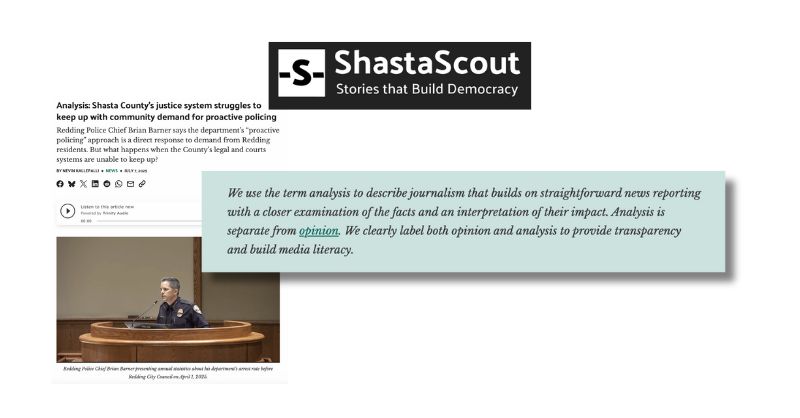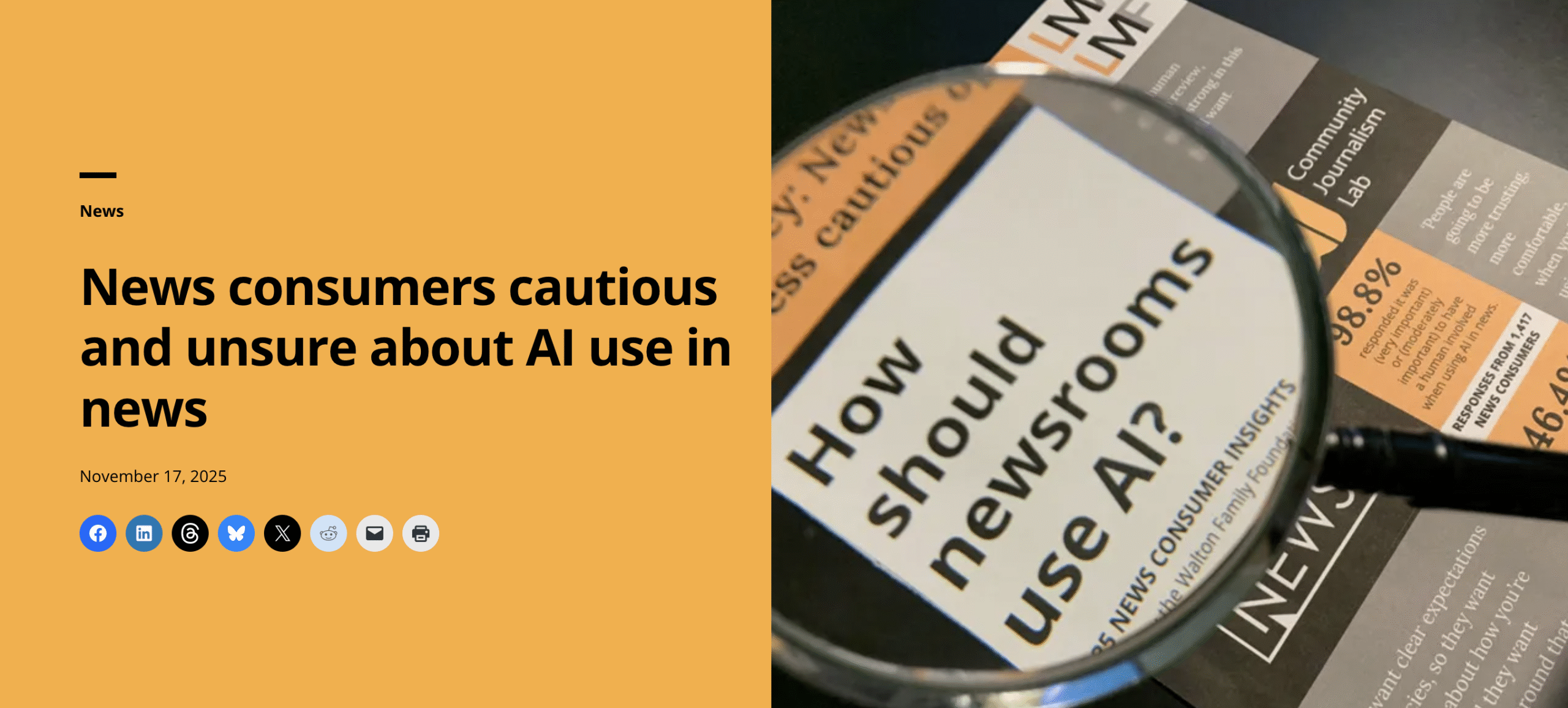
Journalists’ use of catch-all phrases, generalized descriptions and labels can make people feel oversimplified and placed into one-size-fits-all categories. This can be true for organizations people belong to, for religious groups, for different opinions, for causes people support, for racial groups, for age groups, for ethnic groups, etc. Rather than painting complex, nuanced pictures of […]
Polarizing, oversimplified reporting causes mistrust. Let’s work on that.
Journalists’ use of catch-all phrases, generalized descriptions and labels can make people feel oversimplified and placed into one-size-fits-all categories.
This can be true for organizations people belong to, for religious groups, for different opinions, for causes people support, for racial groups, for age groups, for ethnic groups, etc. Rather than painting complex, nuanced pictures of people’s perspectives, we too often use broad strokes.
In addition, journalists often gravitate toward dramatic or extreme views, which can reinforce polarizing narratives and give the impression that most people share those views.
How can journalists resist the allure of lazy narratives and tell more accurate and more complex stories about the spectrum of perspectives in their communities?
Let’s talk about it.
As we continue to kick off our new initiative, A Road to Pluralism, along with our Pluralism Network, we’re going to dig into a series of challenging questions that we think are crucial for local journalists to address. We’ll talk about five topics that we believe are contributing to the perception that local news is part of the problem in a polarized society, rather than a trusted resource across the political spectrum. (In this video, hear us talk about the five themes and what we learned in recent research with the Center for Media Engagement.)
Today’s focus: generalizations and polarization in news coverage.
Let’s start with research
Here’s some national context: Members of Congress with the most extreme views get more airtime from major network and cable TV news outlets than other political leaders, researchers have found. The highlighting of these extreme views by news organizations contributes to the growing polarization in the U.S. It also causes the public to increasingly dislike opposing political candidates.
Those perceptions are mirrored in how local news consumers say they are portrayed. We conducted new research with the Center for Media Engagement to better understand the societal and psychological forces that influence polarization and perceptions of local news. The research suggests one way journalists can help bridge the divide between the news media and conservative, right-leaning audiences is by avoiding catch-all labels and over-generalizations.

According to the research, “multiple interview participants said they felt that media portrayals of conservatives seem to rely on narrow or extreme stereotypes, which they felt assume conservatives are racist, uneducated, unkind, or only care about money.”
(We invite you to join us on Thursday for an informal conversation about generalizations and polarization in news coverage. Register here.)
This doesn’t just apply to conservatives though.
According to additional research from the Center for Media Engagement, “Black Americans across the country and people living in the West and South Sides of Chicago feel the media under-represents or poorly represents them. Analysis of Chicago media coverage supports these perceptions.”
The takeaways from the survey of Black Americans showed journalists aren’t well known in Black communities, Black communities didn’t know how to connect with journalists, and journalists aren’t trusted to tell stories about the Black community with context and complexity.
(Apply now for our free class // Trust 101: Earning Trust with Communities of Color.)
The question applies across categories. How many times have you read a news story where the journalist lumps a whole generation or group of people together when they have only talked to a handful of individuals who fit into that group?
Maybe it was a story about millennials regretting home ownership or a piece about the Black voter. How can you describe a voter just based on race? You really can’t. People are too complex to be boiled down to just their race or just their religion or just which generation they belong to.
Yes, I know there is sometimes data (the census) and surveys where it’s possible to drill down into more specifics, making it possible to describe people and their tendencies based on race, religion, sex, age, where they live, etc. But not all of these stories containing generalizations have that data to support them. Add to that the tendency to oversimplify when it comes to headlines, social posts and other summaries, and you can understand why people may not trust journalists to properly describe them or people like them.
On top of the generalizations, you often see journalists and news organizations focus on the most extreme views. We highlight the most intense college sports fan, the most active PTA parent, the loudest Trump supporter or the most extreme environmentalist. Yes, these people can make for great characters for good stories. But if we only focus on the extremes, aren’t we just contributing to the polarization and the idea that people are on opposite sides?
Then there is the language we use. If you take a look at headlines, especially with political stories but not solely, you often see them framed as someone winning or someone losing. The focus is on the fight, the argument or who won vs. what happened. What would it look like if journalists paid closer attention to this language? Could we change the narrative and help create more productive conversations in our communities?
Our work at Trusting News is always solutions-focused and aimed at developing strategies that will improve the relationship journalists have with the people they aim to serve. We do not want to make journalists feel discouraged by highlighting this criticism. We know how hard journalists work, and we know the job isn’t easy. Instead, we want to share what we are hearing and seeing from users, with the goal of helping journalists produce news content that can be better for everyone it serves.
We also understand asking these types of questions about a story and our reporting may not always be possible. Staffs are shrinking, and breaking news seems to happen at a quicker speed than it used to. But, I think there are ways to produce more accurate and more complex stories about the spectrum of perspectives in our communities, and we are here to help make that a reality.
Related resource from Solutions Journalism: 22 Interview Questions to Complicate the Narrative
What we’ve heard from local journalists
Here’s a collection of observations from our newsroom partners and other journalists who’ve gotten in touch with us on the topic of generalizations and polarization in news coverage. Some are from our recent interviews with right-leaning news consumers, and some are from our work more generally.
- We tend to paint conservatives with a broad brush, one that is unfavorable. They feel we don’t hold democrats as accountable, we are willing to point out falsehoods and conspiracies with republicans but less likely to do so with democrats.
- All three news consumers interviewed expressed extreme dismay about how conservatives were portrayed. Not just Trump, but how individuals, real people were portrayed.
- People perceive us as giving a lot of attention to the fringes, and they don’t see themselves as part of those fringes.
- If you are wrong about me and who I am, what else are you wrong about?
- In a way, this is basic journalism and a good reminder that there is a range of opinions on any given issue. It is important to reflect communities; this should be the overall goal.
- We do this all the time: Hispanics believe X, the Black community feels Y. Every time we go broad, it’s a mistake. We need to do a better job with language and do a better job of explaining what we are doing here
- When covering the issue of the police, we often focus on defunding the police or blue lives matter. But there are so many opinions in between.
- There are people we can talk to and are open to listening to different points of view. We have to continually reach out to those people and engage those people. Or we become irrelevant.
- When we pay attention to the most “newsworthy” things that happen in some communities or neighborhoods, we paint an inaccurate picture of what life is really like there. It feels sensational and just plain wrong.
- In a community with a lot of people who are very religious, people who have a strong connection to their faith, the fact that we don’t regularly cover religion in a significant way really impacts them. We can’t just write these people off.
- I heard from a Hispanic man who felt like we would assume he would be more on the side of open borders and was strongly the other way. We don’t fully appreciate that in the media. How we portray those issues can really have an effect.
- I talked to a conservative who doesn’t go to church. One who’s vegan. One who talked about transgender issues being important. One said journalists think all conservatives are “gun-toting hillbillies with MAGA hats.”
- When I went to a nearby town to report something, a source told me I didn’t seem to understand it well enough. And she was right. I can’t talk to a handful of people and claim to be able to represent what people in the town think about a complex issue.
Questions we’re ready to see local newsrooms ask
With our new Pluralism Network, we’re committed to working with newsrooms to find solutions to these complex problems. On the topic of generalizations and polarization in news coverage, here are some questions we’re ready to ask.
How do we emphasize extreme views?
- How do we choose who to talk to for our stories?
- How do we choose what to highlight in headlines, social posts or other summaries?
- When would it be better not to interview the most outspoken people in our communities?
Why do we emphasize extreme views?
- Do we go to the extremes because it is easier? Are the people who are extreme more accessible and likely to be interviewed?
- Are our deadlines too tight to allow for time for multiple perspectives?
- Do we highlight the extremes because we think it will lead to more clicks, viewers or listeners?
How does journalism flatten out complex views?
- How can we complicate the narrative and cover polarizing issues without making them worse?
- How can we make room for those voices we are not currently hearing from?
- Are we making room for surprising, unusual or contradictory views?
- Are we making room for views that seem more moderate and not extreme?
How do we make assumptions and reinforce stereotypes?
- How do we categorize people in ways that are too convenient or simple?
- How do we label or group people in ways that can make them feel unseen and misunderstood?
- Why are we saying “Group A thinks x” or “Group B thinks y” when we have only spoken to a couple or handful of people in those groups? What are some alternatives?
How do we add to polarization?
- Why do we make stories about fights or arguments or battles? Why do stories have to have a winner or a loser?
- Can we focus on what happened without it being about the fight, battle or outcome?
- What language is seen as polarizing by our audiences? And when is it appropriate to avoid that language?
At Trusting News, we learn how people decide what news to trust and turn that knowledge into actionable strategies for journalists. We train and empower journalists to take responsibility for demonstrating credibility and actively earning trust through transparency and engagement. Learn more about our work, vision and team. Subscribe to our Trust Tips newsletter. Follow us on Twitter and LinkedIn.

Assistant director Lynn Walsh (she/her) is an Emmy award-winning journalist who has worked in investigative journalism at the national level and locally in California, Ohio, Texas and Florida. She is the former Ethics Chair for the Society of Professional Journalists and a past national president for the organization. Based in San Diego, Lynn is also an adjunct professor and freelance journalist. She can be reached at lynn@TrustingNews.org and on Twitter @lwalsh.



